We have entered…a MAELSTROM! Russ Maheras’s Maelstrom, that is, issue one!

Maelstrom 1: Spring, 1974
Publisher/editor: Russ Maheras
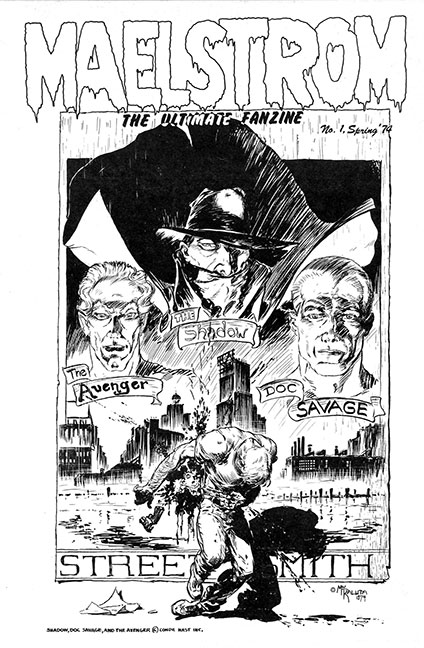
I was so jealous of Russ Maheras.
That darn guy was all over fandom, including the cover of The Buyer’s Guide! Oooooo, I was so jealous! Why did he have to turn out to be such a darn nice guy, fer crying out loud? You can find Russ on Facebook, where he regularly posts about fandom, including covers of TBG (not just his own). Maelstrom was his first (and only) fanzine, and lasted three issues.
When I asked Russ how and when he started reading comics, he replied with
I’ve read comic books for as long as I can remember, and initially, I read every genre. In 1962, at the age of eight years old, I was instantly captivated by both the Civil War News and Mars Attacks trading cards when they hit the counter of my local mom and pop drug store, which, back then, was on the corner of Lincoln Avenue and Racine on Chicago’s north side. I also loved dinosaurs, and remember especially loving Turok comics and the DC war books featuring soldiers battling all manner of prehistoric beasts. But it was in the spring/summer of 1967 when I was suddenly bitten by the Marvel bug – no doubt because of Stan Lee’s clubby Stan’s Soapbox columns. By that time, we had moved to an apartment building on the west side, and so I consciously bought my first Marvels off of the spinner rack of a mom and pop store that used to be located on the southwest corner of Chicago Avenue and Lavergne. I specifically remember purchasing Fantastic Four #63, Amazing Spider-Man #49, Avengers #41, The Mighty Thor #141, Fantasy Masterpieces #9 and a few others [what a memory! -Ken]. And while I had fooled around with drawing a year or so earlier, it was that summer, at the age of 13, when I started getting serious.
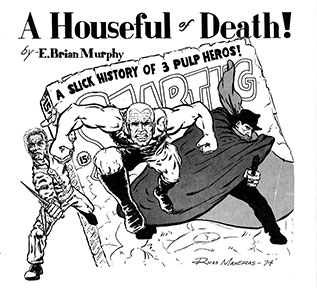
As you can see from the cover above, Russ knew how to start a fanzine! None other than Michael Kaluta graces the cover! And it is not a fluke, as it previews an article inside on a trio of pulp heroes by E. Brian Murphy (see the illo by Russ at left). And Russ was no slouch at production either. This issue has 60 pages full of content, mostly strips (about half by his compatriot, Roy Kinnard), with a few pin ups added for variety. You have to admire that kind of output from a 19 year old! He was also pretty darn good at the design of the book. From the cover logo glued to the Kaluta cover to the contents page below. Few zine editors put visual teasers on the contents page, if there even was one at all.
Russ talks about that cover below, saying it was just…
Dumb luck. Kaluta had just been pulled from The Shadow when he received my letter, and he was out of work. He charged me a nominal rate for the job – much less than his DC rate – and asked that he retain the copyright, and get his original art back. I readily accepted. The design was entirely his. All I did was ask for a cover featuring the big three Street and Smith pulp characters (The Shadow, Doc Savage, and the Avenger), and the illustration he came up with was the end result. The idea was for the cover to be a tease for E. Brian Murphy’s Street and Smith article inside, titled A Houseful of Death. Obviously, Kaluta didn’t need any Shadow reference material, but I tore off the covers of some Doc Savage and Avenger paperback reprints and sent them to him to help out.
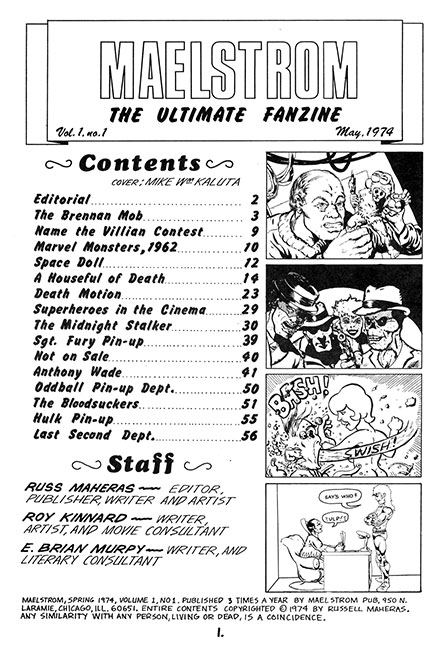
Russ, as I said, was heavily involved in fandom, about which he says
While I knew kids in the neighborhood who read and had comics, I had zero knowledge of any organized fandom until I started going to Joe Sarno’s basement “comic shop” about six miles away from where I lived, circa 1970 or so. Joe put classified ads in the Chicago papers advertising that he had comic books for sale. My mom or dad noticed the ads, and mentioned it to me. I was extremely excited, so my dad and mom drove me over there the first couple of times, and once they checked it out and made sure Sarno wasn’t some kook, they let me take the bus over there. At the time, there was really nothing resembling a modern-day comic book shop in Chicago, so Joe was a pioneer in that regards. Soon, Joe was able to rent a nearby storefront, and he established a no-kidding comic book store. The caveat? Joe could not get new comics distributed to his store because Chicago’s only distributor, Charles Levy Circulating Company (a company that, coincidentally, hired me as a union warehouse worker in the summer of 1974), would only let retailers buy comics if they also carried a minimum number of regular newsstand magazines, such as Time, Reader’s Digest, et al. So, while I went to Joe’s store fairly regularly to hobnob with other comics fans, I still had to buy my new comics at local mom and pop stores back in my neighborhood. It was in Joe’s basement, and later in his first store, I met folks like Alan “Jim” Hanley, Jim Engel, Chuck Fiala, Gary Ricker, Ron Massengill and George Breo. Both Hanley and Breo were fanzine publishers – the former published Comic Book, and the latter, Chronicle – and it was their early ‘zines that planted the seed for me to someday publishing my own fanzine. Sarno, Hanley and Engel became good friends, and Breo got me a brief, part-time, silk-screening job at Armstrong Tool Company, where he worked. Joe, of course, ran various successful comic book stores in the Chicago area for more than three decades, and he was one of the co-founders of the Chicago Comicon.
He mentions some publishing history below.
Prior to Maelstrom, the only fan publication I’d drawn anything for was The Buyer’s Guide for Comic Fandom. However, during my second senior year in high school (1972-1973), I somehow managed to wheedle my way into being the art editor for my Lane Technical High School newspaper, The Lane Warrior (formerly The Lane Daily). I further managed to convince the teacher/advisor overseeing the newspaper to publish a full-page comic strip I drew titled, Teen Avenger. The strip was crude, but the newspaper gig was a great stepping stone to Maelstrom. It was about this same time I sent a modest portfolio of my comics art to Stan Lee, who wrote a terrific letter of encouragement back. You can read about the entire episode as well as other stories here, here, here, and here.
There were a lot on ‘zines I contributed to. A partial list includes Afta, Amazing Science Fantasy, Bumbazine, CAPA-alpha, Cartoon Loonacy, Chicago Collector’s Chronicle, Claw, Comic Eye, The Comic Reader, Comic Times, DC Reader, Hodge-Podge, It’s a Fanzine, Nostalgia Journal, Nova, Ppfszt, Realm, Sensawunda, Slam Bang, Small Press Comics Explosion, Tetragrammaton Fragments, UFO Jam, Unpublished, and Yikes. My favorite editor back in the 1970s was probably Bill G. Wilson, whose fanzine, The Collector, was the gold standard for fanzine publishers.
The first story in this first issue starts out with a bang (literally) in Brennan Mob, where a classic gangster group come back from the dead to reenact their criminal vengeance. See a few pages below.
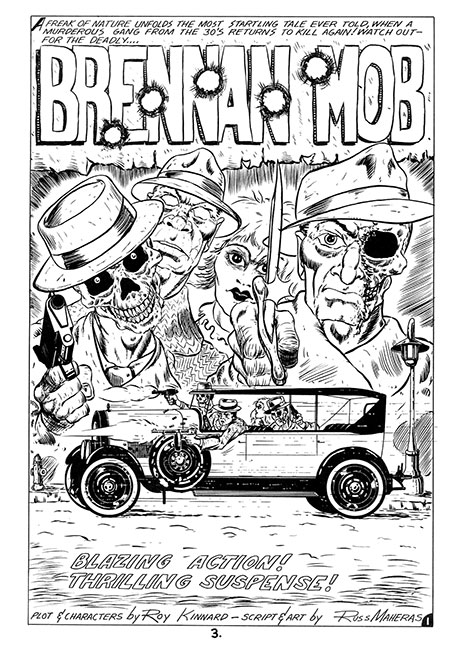
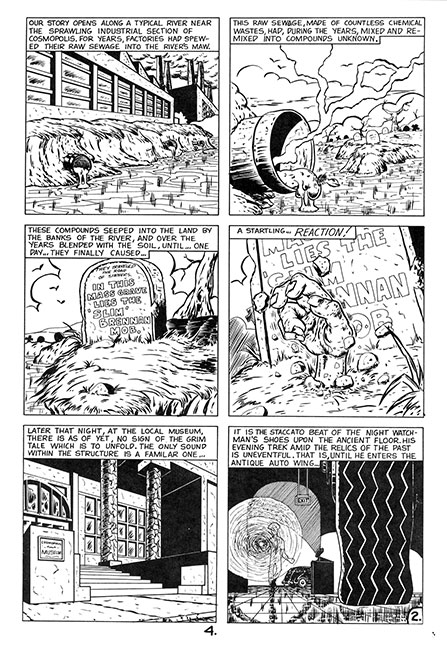

You can really see the Kirby influence (along with Ayers, self admitted influences on Maheras) in that last page! He talks below about his influences and practices.
My comics art was totally self-taught. Three years of drafting in high school was helpful, but the only art class I ever took was a total bust. It was during my junior year, and despite the fact I was the second best artist in the class, I ended up with a final grade of D. The best artist in the class, by far, was a fellow comics enthusiast named Dale Herring, who got a C. Both of us were stubborn rebels, and while the rest of the double-period class was drawing bowls of fruit, Dale and I were sitting in the back drawing comics. We weren’t even sure our teacher, Mr. Cooper, could draw. He’d assign something at the beginning of class, and then vanish to the darkroom to develop photos, or wander off who knows where. Curiously, I hated the sketch book part of my art class, and unlike any other artists I know, that sketch book disdain followed me throughout my life. I might doodle occasionally, and I regularly do preliminary layout sketches for projects, but a sketch book? Nope. To me sketching without a specific purpose is like getting a root canal. Dale, by the way, apparently never got into comics. Today, he is a church deacon.
Want names? Russ has em…
The list [of influences] is endless, but by the time I was 18, I was studying and/or appreciating Will Eisner, Steve Ditko, John Buscema, Wally Wood, Walt Kelly, Will Elder, Frank Frazetta, Curt Swan, Neal Adams, Jim Steranko, John Severin, Jack Davis, Carl Barks, C.C. Beck, Joe Kubert, Berni(e) Wrightson, Michael Wm. Kaluta, Jeff Jones, Gil Kane, Joe Sinnott, Johnny Craig, Alex Raymond, Hal Foster, Mort Walker, Russ Manning, and many, many more. And let’s not forget the great Russ Heath, whose “Russ” signature I swiped – for the simple reason you can’t mess with perfection! Very late in the game, I discovered Milton Caniff, so it was cool when I was able to draw, for the Air Force Times, a fully-authorized Steve Canyon 50th anniversary strip in 1997, and a 60th anniversary strip in 2007. For those two strips, I promoted Canyon from a colonel – his rank when the strip died with Caniff in 1988 — to a brigadier general.
In addition to all the horror and fantasy themes, there is humor in the pages as well…some of it pretty goofy (he was 19, after all, with Kinnard being only a few years older). Check out this homage to the Kirby monsters of the 60s below.

Roy Kinnard helped write a few stories and drew a few as well. Kinnard’s art is pretty simple, with none of the brush wielded embellishment seen in Maheras’s work. Check out a few pages below of his work (the first one inked by Russ).
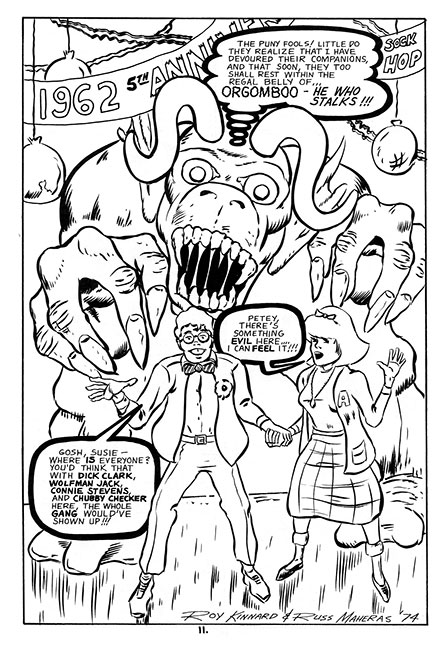
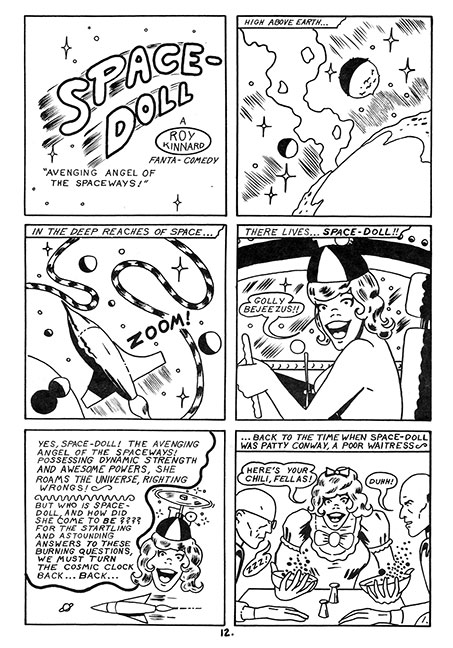
Later in the issue, Death Motion appears, adorned with a character modeled after stop motion animator genius, Ray Harryhausen (the main character’s name a typically punny Harry Rayhausen). Oh, the humanity seen in the pages I did not show below!
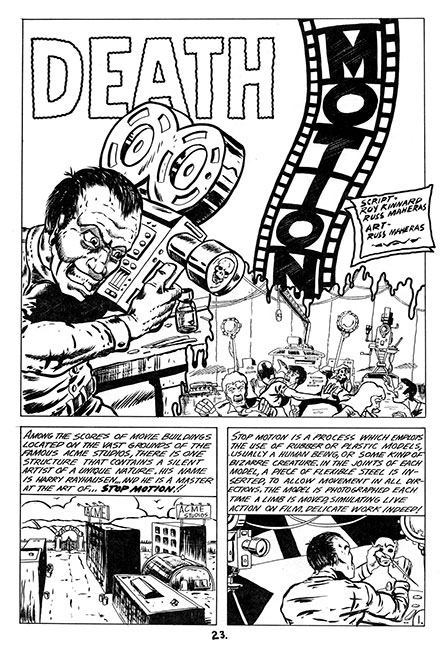
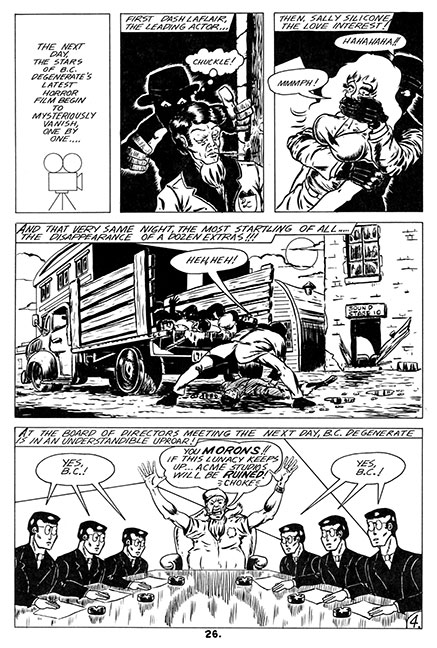
A one page feature entitled Superheroes in the Cinema follows by Kinnard, and then another story by Kinnard called The Midnight Stalker meets the Beast of Berlin. His art reminds of the prodigious fan artist, Tim Corrigan…but…even simpler. He does another story later in the zine, Bloodsuckers. Below you can see another example of the shared humor in the zine.

Roy and Russ follow with a ten page story, Anthony Wade, which showcases Russ’s penchant for in your face compositions and bits of over the top detail as well, as seen below.
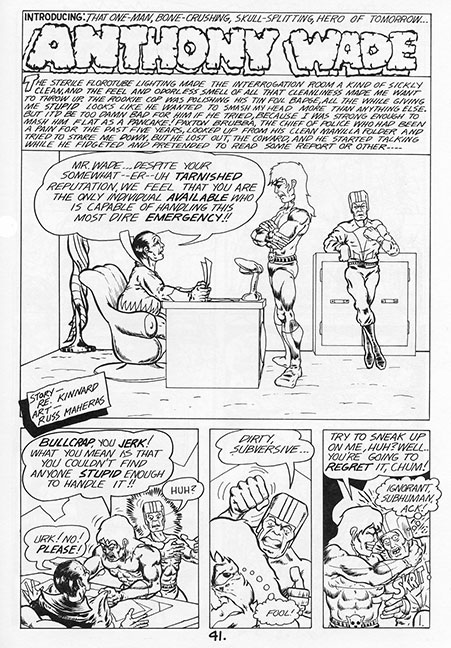
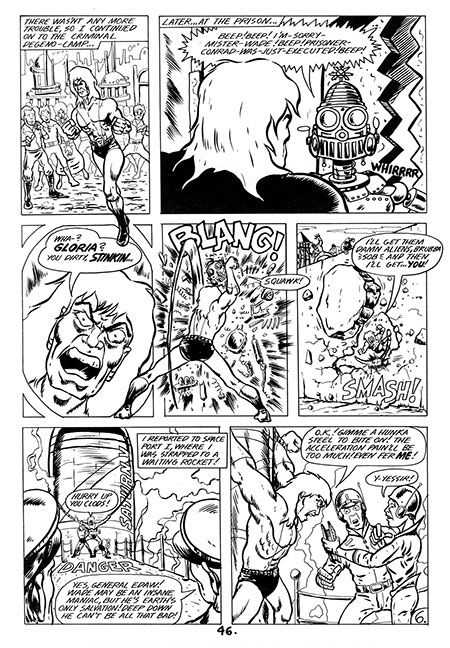
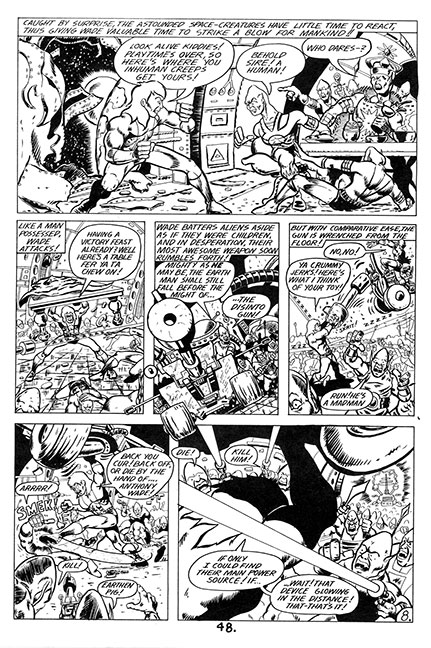
The Buyer’s Guide was mentioned earlier (re: my jealousy), and below, Russ elaborates on that.
I knew nothing about The Buyer’s Guide for Comic Fandom until a Chicago comics dealer, hustler, and ex-Marine, Frank Craft, approached me in late 1972 to draw an ad for a planned comic book convention, Chicago Con 1, scheduled for the summer of 1973. Frank was, I think, a co-owner of the Atlantis Bookstore, which was technically one of the first comics-only stores in Chicago. It was near downtown Chicago, located on Clark street, and it was right across the street from ABC Bookstore, a decades-old bookstore that, up until the early 1970s, was the one of the only sources of old comics in Chicago. In any case, I had spent a couple of months sorting comics for Frank as a part-time side job – getting “paid” in comics – and when he found out I could draw, he asked me to do two separate ads. Those ads pre-date Maelstrom by more than a year, and I drew them while still in high school. The first ad was published in TBG #28, Jan. 15, 1973, and appeared to two more issues before the convention was suddenly canceled. This con was NOT the precursor to the Chicago Comicon. It was a con that never was. My second brush with Alan Light’s TBG came about 18 months later, when I drew my first cover – a Captain America piece that graced the cover of TBG #62, July 15, 1974 – right between Maelstrom #1 and #2. Alan “Jim” Hanley influenced my submission, as he was already regularly doing artwork for Light. In all, I had a hand in about 25 TBG covers, with an additional seven covers that were reprinted as covers to later issues.
There are also a few pin ups contained in the pages of this initial issue of Maelstrom that you can see by downloading the pdf from my site here.
Like many men back then, Russ ended up in the service, and that is explained more thoroughly below.
Actually, I did not join the Air Force until the fall of 1978. It’s a long story, but just as my art was pro caliber, I realized I simply couldn’t go the freelancer route for a wide variety of reasons. In a nutshell, I was practically militant about creator ownership and keeping one’s original art, and after four years in a union, I was spoiled forever when it came to basic worker benefits like medical, dental, paid vacation, paid holidays, a guaranteed 40-hour workweek, and seniority. Yet, I also knew I would go crazy if I had to work in that same warehouse for 41 more years. One day, I casually sent in an Air Force careers postcard from an issue of Popular Science, and forgot about it. A month or so later, my phone rang, and it was an Air Force recruiter. Suspicious, I said, “How’d you get this number?” and the recruiter, Staff Sergeant Randy Quinn, responded matter-of-factly that I’d sent the Air Force a postcard, and he was the recruiter for my Zip Code. Quinn invited me to the recruiting offices, and I must say he was totally open and honest with me. If he had not been, I’d have walked. I took the ASVAB test, and my scores were so high, he told me I could pick any job I wanted. I knew I wanted an electronics job, so I opted for “open electronics.” The Air Force had all of my union benefits except overtime, but it also had a lot of additional benefits – like tuition assistance, and this jaw-dropper: 30 days paid vacation from Day 1. Do you know how many years it would have taken for me to get four weeks paid vacation at my union job? More than 20 years! The original plan was to just do one four-year hitch, learn electronics, and get out. I even got a union withdrawal card so, if I had to, I could get my old job back – with no loss in pay or seniority – after my first enlistment was up. Well, as it turns out. I opted to stay in, and make it a career. I retired in 1999. If I had stayed at CLCC, I would be eligible to retire in June of this year.
I shall leave you with the back cover, which was published several times later in Marvel’s Crazy magazine, which Russ talks about below…
When Maelstrom #1 was published in May 1974, the Charlie World ad spoof was on the back cover. I created about 90 percent of the ad, and the rest was done by my friend and fellow Maelstrom contributor, Roy Kinnard, who wrote some of the text in the “Here’s how” section. I sent a sample copy to Marvel, and it apparently caught Roy Thomas’s eye. He then apparently showed it to Crazy editor Marv Wolfman, who then contacted me and offered to buy the script for $20. I said OK, and Marvel had someone basically trace my strip, polish up some of the lettering, and then typeset the rest. The re-done strip was published, uncredited [italics mine], in Crazy #9 (Feb. 1975). It was reprinted in Crazy #26 (June 1977), Crazy #61 (April 1980), Marvel UK’s Frantic Summer Special (1980), and, finally, Avengers #1 1/2 (1999). To date, the strip still remains uncredited. Can you believe it? My first pro sale, and still no credit!
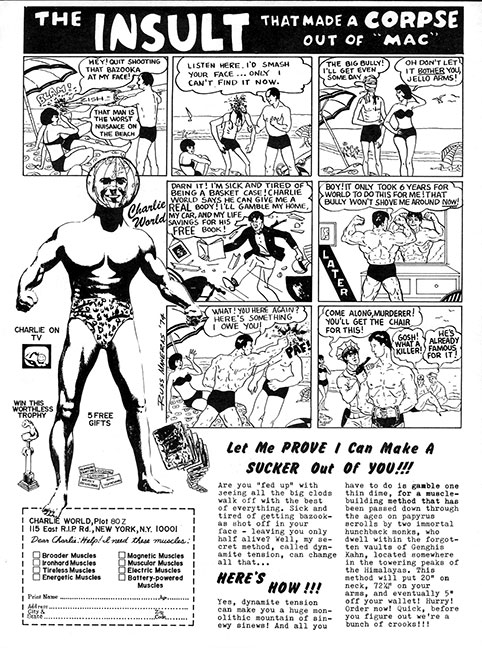
Of course, Russ’s love of art did not end with Maelstrom, as he says, “Hoo boy! You wouldn’t believe how much stuff I’ve done, both professionally, and for fan publications. I could fill pages and pages. Most recently, I drew sketch cards for eight different Topps trading card series, including five that were Star Wars-related, and three that were Mars Attacks-related. In addition, I am currently doing sketch cards for another company, for a project I can’t yet discuss.”
Thank you, Russ, for the issues and answering all of my questions! And yes, I am still jealous.
See you next time for more fanzine goodness.
Ken Meyer Jr.
kenmeyerjr@yahoo.com


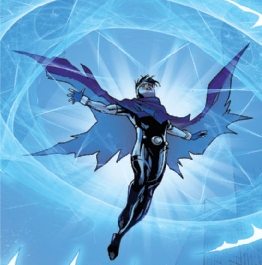
Great zine! I’ve always been a big fan of Russ’s work and really enjoyed seeing this! Thank you Ken!
Russ is a great artist, I remember seeing his work in the Buyers Guide constantly
Delighted to see the zine, and learn more about Russ. Thanks!
Hey, a record 3 comments! Thanks, guys!
Thanks a bunch for highlight my first foray into self-publishing. It’s a great retrospective. My only correction is there were actually eight issues. The first two issues were published in 1974, the third in 1987, the fourth in 1988, the fifth in 1989, the sixth in 1990, the seventh in 1999, and the last issue in 2002.
What a GREAT article on a GREAT guy and his GREAT work! Just…GREAT!
Thanks for all the comments, people!
7 and counting!